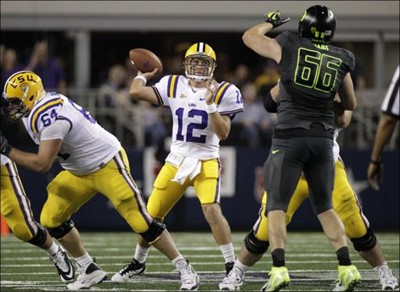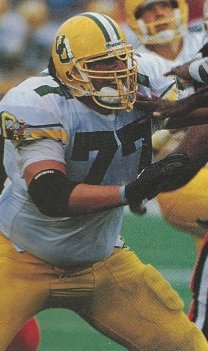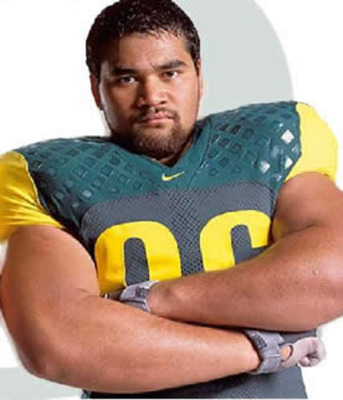 Not sure when exactly, but it must have started back sometime around 2006 or 2007…that’s when the nation began to take notice of the new wave spread offensive schemes being installed in Eugene, the flash and bravado turning many into new Duck fans, while others scoffed at it just being a gimmick, not real football. Perhaps instead it was the ever-changing and polarizing uniform modifications coinciding with the switch in offensive philosophies that had something to do with calling national attention to this wacky wide-open high scoring team that led to the change in perception.
Not sure when exactly, but it must have started back sometime around 2006 or 2007…that’s when the nation began to take notice of the new wave spread offensive schemes being installed in Eugene, the flash and bravado turning many into new Duck fans, while others scoffed at it just being a gimmick, not real football. Perhaps instead it was the ever-changing and polarizing uniform modifications coinciding with the switch in offensive philosophies that had something to do with calling national attention to this wacky wide-open high scoring team that led to the change in perception.
Regardless of what instigated it, Oregon asked to be in this spotlight, and the backlash has been consistent, the stigma that has been slapped upon Oregon for the last few years being a generalized topic by broadcasters and media pundits alike–that Oregon is a “small” football team compared to others in the top 25.
Perhaps it was the high-profile losses against Boise State, Ohio State, Auburn, or LSU (four of the six total losses Oregon has suffered since Chip Kelly became head coach). Those games on the big national stage had a common theme, the Oregon offense struggling at times to move the ball against a mostly NFL-ready defensive front fielded by those respective teams (well, excluding BSU).
From a historical standpoint, Oregon has been mostly seen as a small-ish west coast school that was hard to find on a map, harder to get to, and assumed ably the role of scrappy undersized underdog that could bite if teams didn’t prepare well for them.
Although the David vs. Goliath mentality was played out in the media when Oregon found success against higher-ranked opponents, it was far more a metaphor than a physical reality in regards to actual average size of the Oregon teams. From the Bill Musgrave era to Joey Harrington leading last-second comebacks, Oregon’s resiliency took center stage over any shortcomings in scale though the media was all too happy to emphasize any individual mismatches in bulk. This was usually played out subtly, with a good-for-them patronizing passive-aggressive stance comparing the Ducks akin to the little engine that could.
But when switched to the spread, the rhetoric and propaganda exploded. Suddenly Oregon was solely a “finesse team,” perceived as too small for big boy football played by major programs or in SEC country. Outsiders found themselves curious about Oregon, they wanted to know why was Nike and Phil Knight so passionate about an inconsistent and somewhat obscure team?
Ok, so the Ducks might have NFL-or-better-caliber facilities, cutting edge uniforms, locker rooms, training techniques, and playbooks; but they still needed bigger players to fill out those uniforms before they could truly compete against the nation’s elite, right? To some it seemed Nike had bought the cart before they had the horses. But Oregon football is deeper than that.
The moment Rich Brooks and his staff (many of whom are still coaching football in Eugene) led Oregon to a victory at the 1989 Independence Bowl, those coaches, this team, this University, this town, and these fans have been building something unique. Five years later when Kenny Wheaton scored in a moment that will never be forgotten by Oregon fans propelling Oregon to a Pac-10 conference championship and Rose Bowl, it sent off a shock-wave of support for the team that has continued to build steam ever since, culminating in a national championship appearance and Rose Bowl victory.

In the 90's Oregon offensive lineman Steve Hardin (#77) tipped the scales at 330+, but even he was dwarfed by fellow OL Tasi Malepeai, playing around 360. Who said these Ducks were small?
Like a tsunami wave, each season-and critics might say each uniform combination-has been a step forward in building towards this exact type of run of success on the field fans have enjoyed the last five years or so. The Ducks may not have always had the most talent, size, or depth, but they have played smarter and faster, bigger and better with each year.
Other teams may not want to admit it, but the biggest waves started by those past Ducks have yet to hit shore. Fans of other teams may be hoping the loss of LaMichael, starting a new QB, or the “certain-to-be” harsh pending NCAA sanctions will somehow ebb the Ducks’ tide, or at least knock them off their perch a little.
Sure, the Ducks may have been undersized, under-skilled, or otherwise lacking depth compared to the nation’s top 10 in some of those years along the way, and for too many seasons a few injuries here or there would expose a hole in the armor derailing an otherwise special group.
But, this next season?
It might be time to finally throw all of that out the window. This year, despite the undersized talking point that will inevitably be associated with spread offenses permanently, the Ducks have the size to go along with all of the speed and sizzle.
The season kicks off for the defending Rose Bowl Champions in a little over a month, the launch of the 2012 season officially commencing earlier this week with Pac-12 Media Day. This day is a small annual oasis in the desert-wasteland that is the long summer months, as the anticipation to college football season grows. The Ducks this year had Chip Kelly, Kenjon Barner, and Michael Clay representing the men of Oregon. The Q&A at these events is a mere formality, the real story isn’t what is said as much as the signal the event provides–football is on the horizon.
In one of the first questions directed towards the Ducks, specifically to senior linebacker Michael Clay, a reporter permeated the myth further, asking about “lacking what the tougher, heavier defenses have in the south, and how do you shake this stereotype?”
Chip Kelly ultimately interjected, and provided an answer, citing “we have guys that go up to 295 and 300, and they run as well as anybody in the country…”
Clearly Coach Kelly, the players, and Oregon fans alike have grown weary of having to constantly respond to this stereotype, that spread offense = lack of size that will get exposed vs. a “real” defense. Match this with “the spread doesn’t prepare an athlete for the NFL” and “it’s just a gimmick offense” and you’ve got the trifecta of ignorance, a frustrating display of misconceptions permeated by media and those who feel perception defines reality.
Like many, I’ve grown weary of hearing about the supposed size disadvantage stereotype, I mean, how much bigger can they really be? I wonder if the Ducks are actually bigger than some of the SEC teams?
What I discovered may surprise you.
As a team, Oregon is in fact bigger than not only many of the SEC schools, but it is difficult finding a team in the country as big in average girth as the Ducks are this year. Sounds crazy, right? Believe it…depending on exactly how “bigger” is defined.
What parameters define a “big” player? How much weight, or height, is enough to appease the media and opposing fans into dropping the undersized label? Sports medicine, training regimens, and nutrition have come a long way in the past few decades, leading to bigger-stronger-faster athletes (coincidentally, Nike’s motto). Whereas not long ago a 300 lb. player was considered massive, even by NFL standards most offensive linemen averaged around 250 during the days of the prolific “hogs,” today it raises an eyebrow if linemen weigh under three-bills.
So is a 6’4″ 299lb player big? Absolutely, by general public standards. But by football standards, is it enough?
Looking through team rosters on ESPN.com, specifically at the basic height/weight dimensions of players, the measurements appear in direct contradiction to the “undersized” label so casually thrown out by the perceived masses.
Oregon currently has 28 players over 6’5″ and/or 300 lbs. This number dwarfs most teams in the country, yes even those in the big bad SEC. Yes, 28 is more than even the “biggest” SEC teams like LSU (23) and Alabama (22). In fact, Oregon has more of these 6’5″/300 players than Arkansas (23), Georgia (21), Auburn (19), South Carolina (18), and Florida (18).
And it doesn’t stop with these “tiny” SEC players. (Maybe their “small” guys are bigger than our “small” guys?) The Big-10 is traditionally known as the home of 3-yards-and-a-cloud-of-dust football, where bulk on bulk is played out in the trenches, the bigger/heavier team ultimately winning out. No teams exemplify this traditional perception of the conference more than Michigan and Wisconsin, yet the Oregon Ducks are bigger than Michigan (18), and even Wisconsin (22) too! The other midwest traditional power, albeit not a member of the Big-10 but long associated with its style of play, Notre Dame were close (24), but still short of Oregon’s tally.
Looking at the Big-12, home of corn-fed hog mollys built to pave running paths through defenses, sure enough Texas (23) and Oklahoma (22) were smaller too.
So who exactly is undersized? Who relies solely on finesse rather than bulk? The national perception is inherently flawed considering the sheer volume of “big” players currently on the Oregon roster.
Oregon is generally considered to be the fastest team in the country, but who would have guessed they are among the very biggest as well? In fact, Florida State (28) was the only team I could find with as many “big” players as the Ducks, a team being hailed in the preseason as a possible national championship contender, primarily because of the supposed superior size along the Seminoles defensive line.
No other Pac-12 team comes close to reaching Oregon’s tally in 6’5″/300 bodies. USC (19) predictably leads the way in competing with the Ducks in this category, with Stanford (17), and UCLA (17) not too far behind. Washington (16) and Cal (14) are not exactly tiny either. Within the state of Oregon, the Ducks have way more than Oregon State (13) and Portland State (9) combined.
So, there you have it. The Ducks are just as big if not bigger than any team found anywhere in the nation. The body type pursued by Oregon coaches to fit the system are thought of as “bullets not bowling balls,” but based on the size existing on the roster it begs the question what caliber bullet is it? This collection of size and speed hasn’t happened overnight, much like Oregon’s tiered baby-step progress since 1989, so too has the scale of Oregon’s roster been a work in progress.
The Oregon Rose Bowl team in 94-95 only had 10 players matching the 6’5″/300 scale.
Haloti Ngata and the ’03-’04 team, known for its massive defensive line? Try only 12 players.
Dennis Dixon and the ’07-’08 team? Getting bigger and better with 17.
In the last few years under Head Coach Chip Kelly, offensive line coach Steve Greatwood, and defensive line coach Jerry Azzinaro, the Ducks have made it a point to pursuer taller, bigger players, their efforts clearly paying off in a “big” way.
Size alone does not make all the difference on the football field. In fact, Duck fans have argued against exactly that point for far too long against those using it as a counter to Oregon’s success as the traditionally undersized squad. But not anymore, if volume is an appropriate measurement, Oregon is not only among the elite in the nation in the polls, but also in that generic size of the team that broadcasters seem so fixated upon.
Sure, those Ducks are fast and flashy, but just too darn small. Can you imagine how scary they would be if they got some players with real size?
To the media and fans around the country with that perception, take notice. The size has arrived in Eugene.
|
Team |
Players over 6’5″/300lbs |
|
Oregon |
28 |
|
Florida State |
28 |
|
Notre Dame |
24 |
|
LSU |
23 |
|
Texas |
23 |
|
Arkansas |
23 |
|
Ohio State |
23 |
|
Alabama |
22 |
|
Wisconsin |
22 |
|
Georgia |
21 |
|
USC |
19 |
|
Auburn |
19 |
|
Michigan |
18 |
|
South Carolina |
18 |
|
Florida |
18 |
|
Stanford |
17 |
|
UCLA |
17 |
|
Washington |
16 |
|
California |
14 |
|
Oregon State |
13 |
|
Portland State |
9 |
And just for reference, here are the comparisons in some of the Ducks notable losses the last few years:
2010 Rose Bowl:
Oregon (19) vs Ohio State (23)
2011 BCS National Championship:
Oregon (19) vs Auburn (21)
2011 Cowboy Classic:
Oregon (21) vs LSU (29)
So who are these massive Ducks you ask?
|
Name |
Height |
Weight |
Year |
Position |
| 1. Stetzon Bair |
6-9 |
265 |
SO |
DL |
| 2. Pharoah Brown |
6-6 |
230 |
FR |
TE |
| 3. DeForest Buckner |
6-7 |
230 |
FR |
DL |
| 4. Cody Carriger |
6-6 |
230 |
FR |
DL |
| 5. Terrence Daniel |
6-6 |
230 |
FR |
WR |
| 6. Dwayne Stanford |
6-5 |
210 |
FR |
WR |
| 7. Colt Lyerla |
6-5 |
238 |
SO |
TE |
| 8. Kyle Long |
6-7 |
300 |
SR |
OL |
| 9. Evan Baylis |
6-6 |
232 |
FR |
TE |
| 10. Arik Armstead |
6-8 |
297 |
FR |
DL |
| 11. James Euscher |
6-7 |
291 |
FR |
OL |
| 12. Trevor Fox |
6-5 |
280 |
JR |
OL |
| 13. Hamani Stevens |
6-3 |
305 |
SO |
OL |
| 14. Ryan Clanton |
6-5 |
296 |
SR |
OL |
| 15. Nick Cody |
6-5 |
309 |
SR |
OL |
| 16. Matt Pierson |
6-6 |
251 |
FR |
OL |
| 17. Tyler Johnstone |
6-6 |
271 |
FR |
OL |
| 18. Taylor Hart |
6-6 |
289 |
JR |
DL |
| 19.Everett Benyard |
6-7 |
319 |
JR |
OL |
| 20. Andre Yruretagoyena |
6-5 |
264 |
FR |
OL |
| 21. Jake Fisher |
6-6 |
279 |
SO |
OL |
| 22.Carson York |
6-5 |
289 |
SR |
OL |
| 23. Christian French |
6-5 |
231 |
FR |
TE |
| 24. Ricky Heimuli |
6-4 |
321 |
JR |
DT |
| 25. Wade Keliikipi |
6-3 |
300 |
JR |
DT |
| 26. Axel McQuaw |
6-6 |
275 |
JR |
DT |
| 27. Dion Jordan |
6-7 |
241 |
SR |
DE |
| 28. Jared Ebert |
6-5 |
267 |
JR |
DT |
Related Articles:
Josh White has been a dedicated Duck fan since the Bill Musgrave days. He has attended (and lost his voice at) virtually every home game and many away games since the late 1980’s, including 96 of the current 97 game sellout streak at Autzen Stadium. A Eugene native, Josh works full time in Eugene area real estate, helping people buy and sell residential and commercial properties, and also volunteers with Habitat For Humanity, Kidsports and Food For Lane County. He welcomes your feedback.
Twitter: @WhiteHouseJosh
Facebook: EugenesBestRealtor

